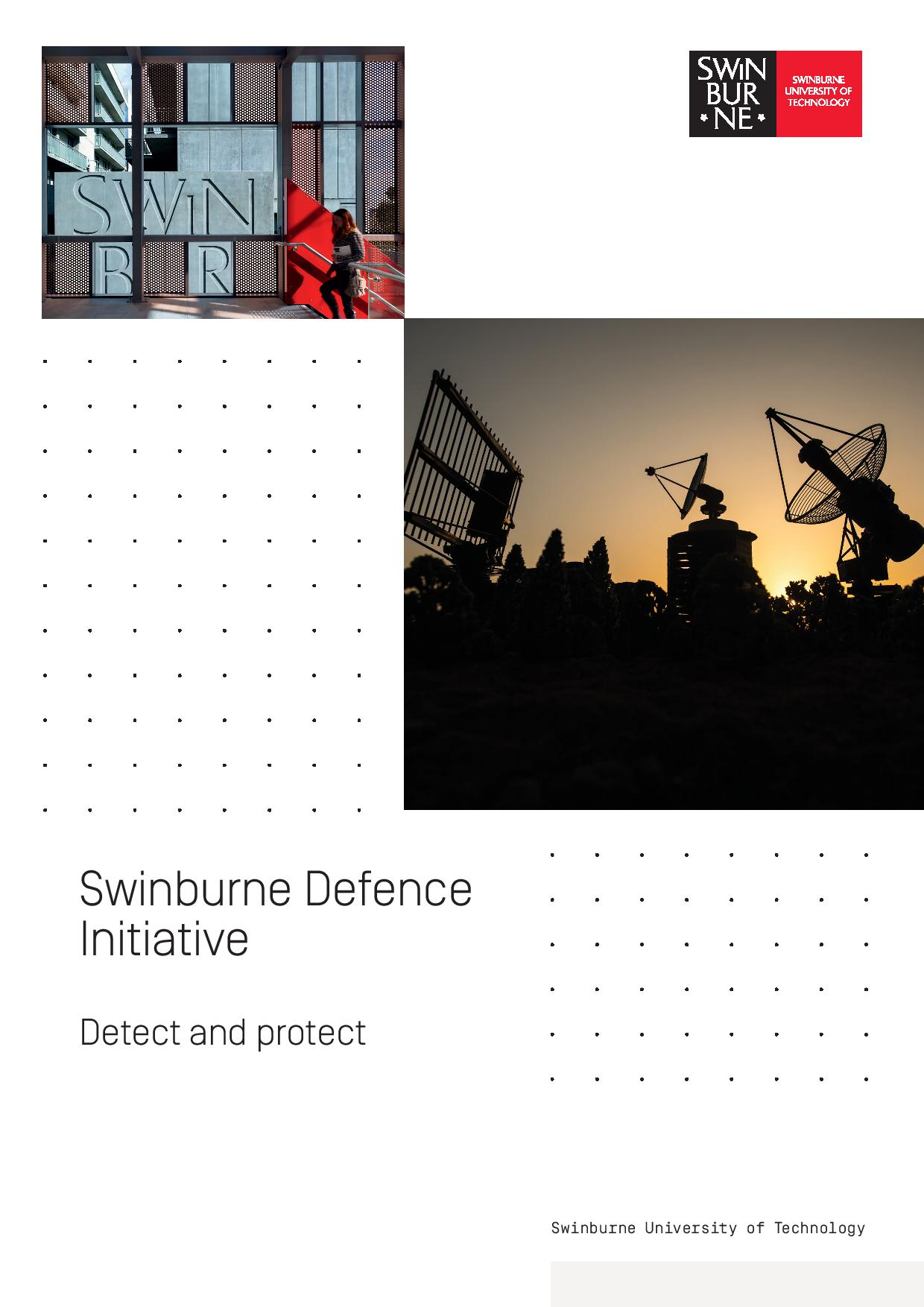
Defence research
A holistic, dual-layer approach to enhancing Australia’s sovereign capabilities
Detect and protect research at Swinburne
Swinburne University of Technology is dedicated to future-focused research that combines science, technology and innovation with humanity to deliver real-world social, environmental and economic impact.
In an increasingly complex and dynamic defence landscape, Swinburne is committed to maintaining and enhancing Australia’s national defence and security through a holistic, dual-layer approach.
The Swinburne Defence Initiative – Detect and Protect outlines our commitment and framework for undertaking defence-related research and innovation, aligned with our flagship research areas, that advances national security for all Australians and the Australian Defence Force.

Swinburne Defence Initiative
Detection research
Detection is crucial for maintaining national security and safety. We conduct research that can identify and discover the presence of potential threats and risks.
This can include the use of various technologies, systems and tools to gather data, analyse information, monitor environments and identify indicators or anomalies that may signify a threat.
Protection research
Protection research strives to remove or mitigate potential threats. This involves the development and implementation of defensive strategies, security protocols, and technologies to prevent, minimise or remove threats.
About Distinguished Professor Saeid Nahavandi
Distinguished Professor Saeid Nahavandi is an internationally recognised expert in defence technologies with a specific interest in intelligent robotic and haptic systems, including modelling and simulation technologies.
He leads the Swinburne Defence Initiative – Detect and Protect and provides strategic leadership in developing industry partnerships and defence capabilities, as well as establishing new initiatives that align with Australia’s national security priorities.

Distinguished Professor Saeid Nahavandi
Associate Deputy Vice-Chancellor Research and Chief of Defence Innovation
Our research capabilities
Swinburne works closely with government and industry on strategic research projects that aim to support and enhance Australia’s national security interests.
Our world-leading researchers and state-of-the-art facilities enable Swinburne to be at the forefront of cutting-edge research that provides tangible impact for our partners. Key areas of focus include:
Space and Aerospace
Swinburne has globally renowned capabilities in astrophysics, aerospace, aviation, engineering and digital technologies. Current research capabilities include:
- radiation sensors (chemical, biological, radiological, nuclear and explosive applications)
- radiation hardened semiconductor chips for operation under space radiation (long-term geostationary missions) and high power radio frequency radiation
- satellites
- satellite instrumentation
- Earth Observation.
Manufacturing Futures
We have extensive expertise in materials science and manufacturing technologies for developing protective systems. Current research capabilities include:
- advanced materials, composites, coatings and structures that enhance the resilience and survivability of military platforms
- laser cladding repair of critical defence components and geometrical restoration of components made of ultra-high strength steel
- distributed sensor networks for monitoring, securing, and safeguarding nuclear materials.
Digital Capability
Swinburne’s cybersecurity and information protection research includes projects that focus on safeguarding military systems from cyber threats and attacks. Current research capabilities include:
- secure communication protocols, encryption algorithms, intrusion detection systems to enhance protection of military networks and information infrastructure
- cyber resilience technologies for developing preparedness of an organisation towards managing cybersecurity risk in terms of systems, data, assets, and human resources
- combining digital technologies, novel radiation sensors and nuclear medicines for improved diagnostic and treatment.
Social and Community
Here we bring together people and technology, engaging with communities and organisations to understand and solve complex societal challenges. Current research capabilities include:
- community engagement and participation, social licence to operate and social impact assessment
- sustainability, environment, waste and recycling
- governance and regulation issues and frameworks
- human interaction with technology, trust and procedural justice
- defence, the media and social media.
Swinburne Defence Advisory Board
Comprising of renowned former leaders of the Australian Defence Force, the Swinburne Defence Advisory Board contributes to the work of Swinburne’s defence-related research and innovation.
Our facilities
Explore the range of cutting edge facilities and equipment on offer at Swinburne.
-

Factory of the Future
The Factory of the Future (FoF) provides industry and organisations with Industry 4.0 transformation pathway and tools, and allows companies to learn digitalisation technologies and explore recent advances in automation of manufacturing.
-

Swinburne supercomputing: OzSTAR and Ngarrgu Tindebeek
Our OzSTAR supercomputing facility here at Swinburne has proven to be an excellent research tool in areas of astronomy ranging from simulations of structure formation in the universe to the processing of data collected from telescopes.
-

Swinburne-CSIRO National Industry 4.0 Testlab
The Swinburne-CSIRO National Industry 4.0 Testlab conducts industrial scale multilayer 3D printing for near net composite manufacturing and solutions for automotive and aerospace parts, processes and systems.
Latest defence news
-

- University
Defence Science and Technology Group placements set Swinburne students up for success
Three Swinburne students have gained invaluable work experiences in STEM through Swinburne’s longstanding partnership with the Defence Science and Technology Group (DSTG).
Tuesday 07 May 2024 -

- University
Renowned former Australian defence leaders make up Swinburne’s Defence Advisory Board
A team of experienced defence experts will offer strategic advice and guidance to Swinburne on matters relating to the defence industry...
Thursday 28 March 2024 -

- University
Swinburne appoints Defence head to tackle crucial and complex landscape
Swinburne University of Technology has appointed Distinguished Professor Saeid Nahavandi as its inaugural Associate Deputy Vice-Chancellor Research and Chief of Defence Innovation.
Wednesday 03 May 2023
Partner with us
Would you like to know more about Swinburne’s world-class defence-related research or discuss a potential partnership? Email defence@swinburne.edu.au to speak to our team today.

